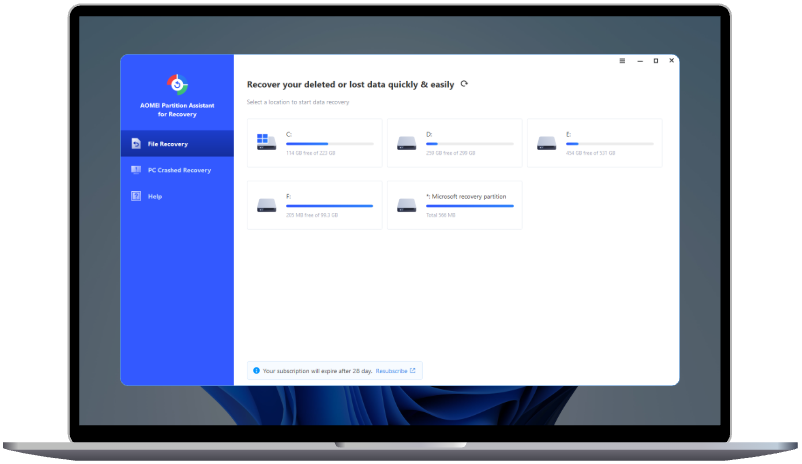User Profile Cannot Be Loaded in Windows! Fix It in 3 Ways!
This article introduces 3 methods to help fix user profile cannot be loaded error. To ensure you can fix the issue without data loss, you need to save your data first before the process.
About the user profile cannot be loaded error
A user profile stores your personal files and settings. Each user on a computer has a separate profile—most commonly a local account, which may be standard or admin. This keeps data organized and secure.
However, some Windows users see the error "The user profile cannot be loaded" when trying to log in, often after a system update or when using a new account. This happens when the User Profile Service fails to load your settings, usually due to corrupted files, software conflicts, or file system errors. As a result, Windows blocks access to your account.
- Here are the most common reasons why the user profile might not load:
- Corrupted NTUSER.dat file: This file saves your personal settings. If it gets damaged, often during updates or system restore, Windows might not be able to load your profile.
- Problems with the User Profile Service: If this service isn’t running correctly, Windows can’t load your profile during startup.
- Antivirus software: Sometimes antivirus programs interfere with profile files, causing them to become unreadable or corrupted.
- Issues in the Windows Registry: The registry holds important settings. If it becomes corrupted, it can stop your user profile from loading.
If Windows can't load your profile, it means something is preventing it from accessing that data. Fortunately, there are effective ways to fix the issue and restore access.
Before fixing the Windows user profile cannot be loaded error
It's a smart step to protect your data before attempting any major fixes for the "Windows user profile cannot be loaded" error. This issue indicates that the user profile is corrupted, meaning Windows can’t properly load your settings and files. Recovering your files in advance helps prevent data loss if you need to create a new user account or reinstall Windows.
Specialized recovery software offers deeper scans, handles complex partition issues, and restores deleted files with their original folder structure—surpassing Windows’ built-in tools. AOMEI Partition Assistant for Recovery stands out for its ability to accurately recover lost data, and it can even recover data after formatting or partition damage.
Designed for Windows, it scans disks thoroughly and restores files to their original path, making it ideal for securing data before fixing the "Windows user profile cannot be loaded" error.
Step 1. Install and launch AOMEI Partition Assistant for Recovery. Choose the exact partition or disk where your data lost and click Scan.
Step 2. Then, the recovery tool start to scan and search. lt will execute the “Quickly Scan" first to find your deleted data fast, and then execute the “Deep Scan" for searching other lost data.
Step 3. Once the scan is completed, all deleted files, recycle bins and other missing files will be displayed. Please select the file you would like to recover and then click "Recover".
Step 4. Then, select a folder path to save your recovered files.
Step 5. Wait patiently for this process of recovering ends.
How to fix user profile cannot be loaded in Windows PCs?
Now, you can back up the data recovered from AOMEI Partition Assistant for Recovery to a safe location such as the cloud or an external hard drive. Once everything is ready, you can try the fix for the User Profile Service Failed to Login issue without risking data loss.
Way 1. Boot into Safe Mode
One way to troubleshoot your Windows computer is by starting it in Safe Mode. This mode loads only essential drivers and files, making it easier to pinpoint the program, file, process, or service causing the "user profile cannot be loaded" error.
Since Safe Mode skips loading potentially corrupt software or files that may be interfering with normal startup, it’s often the only way to access your system and resolve the issue. Here’s how to boot your Windows PC into Safe Mode:
Step 1. Open your computer and quickly press the F8 key or the Ctrl key to access the Startup Settings screen. Subsequently, use the F4/F5/F6 keys to select the desired safe mode for booting.
Step 2. After a few minutes, your computer will enter Safe Mode.
While your computer is in Safe Mode, you can access Windows and make necessary changes to help resolve the issue.
Way 2. Create a new local user account
If the issue persists, you can transfer data from the corrupted profile to a new local user account created in Safe Mode. This is helpful if previous fixes haven’t resolved the problem, likely due to severe corruption in the original user profile.
Step 1. While in Safe Mode, open the Command Prompt by searching for it in the Windows Search box. In the Command Prompt, type the following command and press Enter: net user /add username password
Note: Replace "username" with the desired name for the new user profile, and "password" with a password if you want to set one (this is optional).
Step 2. Next, type this command and press Enter: localgroup administrators username /add
Again, replace "username" with the name you chose for the new profile. Once completed, you can log into the new profile and transfer data from the corrupted profile. To prevent data loss, it’s recommended to back up the user profile before creating a new one.
Way 3. Replace NTUSER.dat file
Your user profile’s settings and preferences are stored in the NTUSER.DAT file. If this file gets corrupted, it can trigger the "user profile cannot be loaded" error. To fix this, you can replace the damaged file by following these steps:
Step 1. Boot your computer into Safe Mode. Press Windows + E to open File Explorer. Then go to the drive where Windows is installed.
Step 2. Open the Users folder. Then click View, select Show, and choose Hidden items to make hidden files visible.
Step 3. Open the Default folder. Right-click the NTUSER.DAT file and select Rename. Rename the file to NTUSER.DAT.OLD.
Step 4. Go back to the Users folder. Open another user profile, copy its NTUSER.DAT file, and paste it into the Default folder where you renamed the old file. Restart your computer and check if the issue has been resolved.
Conclusion
The user profile cannot be loadederror is often fixable with the right steps. Whether the issue is caused by corrupted files, profile settings, or system errors, methods like Safe Mode, creating a new user account, or replacing the NTUSER.DAT file can help restore access. Please recover and back up your data first with AOMEI Partition Assistant for Recovery to avoid any loss during the repair process.

